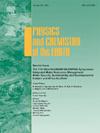Quantitative source apportionment and health risk assessment of potentially toxic elements from the surface water and groundwater in a typical coal-mining area
IF 3
3区 地球科学
Q2 GEOSCIENCES, MULTIDISCIPLINARY
引用次数: 0
Abstract
Globally, water affected by potentially toxic elements (PTEs) from coal mining activities has threatened human health. The source apportionment and health risk assessment of these PTEs have yet to be further analyzed. Thus, the objectives of this study are to understand the main exceeding PTEs, quantify their source contributions, and estimate associated human health risks. 26 groundwater (GW) and 22 surface water (SW) samples were collected from the coal mining area of southwestern China. Fe (ER, GW: 46.15 %, SW: 77.27 %), Mn (GW: 26.92 %, SW: 77.27 %), and sulfate (SO42−) (GW: 15.38 %, SW: 18.18 %) exhibited higher rates of exceeding the limit in groundwater and surface water, respectively. The source apportionment showed that natural factors, agricultural processes, coal mining activities, and wastewater discharge commonly controlled the concentrations of the chemical components in the groundwater and surface water. The iron (Fe) and manganese (Mn) were attributed to coal mining activities, nitrate (NO3−) was from agricultural processes, and fluoride (F) and arsenic (As) were derived from trace element minerals, with As also linked to coal mining activities. Health risk assessment indicated that the groundwater and surface water posed significant non-carcinogenic health risks for children (ER, GW: 23.08 %, SW: 36.36 %), females (GW: 23.08 %, SW: 36.36 %), and males (GW: 23.08 %, SW: 31.82 %). Among these PTEs, arsenic (As) had the most significant impact on the human health of various populations. This research provided a valuable understanding of protecting the water environment in coal-mining areas worldwide.

典型矿区地表水和地下水中潜在有毒元素的定量来源分配及健康风险评价
在全球范围内,受煤矿开采活动产生的潜在有毒元素(pte)影响的水已威胁到人类健康。这些pte的来源分配和健康风险评估有待进一步分析。因此,本研究的目的是了解主要的超标pte,量化其来源贡献,并估计相关的人类健康风险。在西南采煤区采集了26份地下水和22份地表水样品。Fe (ER, GW: 46.15%, SW: 77.27%)、Mn (GW: 26.92%, SW: 77.27%)和硫酸盐(SO42−)(GW: 15.38%, SW: 18.18%)在地下水和地表水中分别表现出较高的超限率。来源解析表明,自然因素、农业生产过程、煤矿开采活动和废水排放共同控制地下水和地表水中化学成分的浓度。铁(Fe)和锰(Mn)来自煤矿开采活动,硝酸盐(NO3−)来自农业生产过程,氟(F)和砷(As)来自微量元素矿物,砷也与煤矿开采活动有关。健康风险评价表明,地下水和地表水对儿童(ER, GW: 23.08%, SW: 36.36%)、女性(GW: 23.08%, SW: 36.36%)和男性(GW: 23.08%, SW: 31.82%)存在显著的非致癌性健康风险。在这些pte中,砷(As)对不同人群的人体健康影响最大。该研究为世界范围内煤矿水环境保护提供了有价值的认识。
本文章由计算机程序翻译,如有差异,请以英文原文为准。
求助全文
约1分钟内获得全文
求助全文
来源期刊

Physics and Chemistry of the Earth
地学-地球科学综合
CiteScore
5.40
自引率
2.70%
发文量
176
审稿时长
31.6 weeks
期刊介绍:
Physics and Chemistry of the Earth is an international interdisciplinary journal for the rapid publication of collections of refereed communications in separate thematic issues, either stemming from scientific meetings, or, especially compiled for the occasion. There is no restriction on the length of articles published in the journal. Physics and Chemistry of the Earth incorporates the separate Parts A, B and C which existed until the end of 2001.
Please note: the Editors are unable to consider submissions that are not invited or linked to a thematic issue. Please do not submit unsolicited papers.
The journal covers the following subject areas:
-Solid Earth and Geodesy:
(geology, geochemistry, tectonophysics, seismology, volcanology, palaeomagnetism and rock magnetism, electromagnetism and potential fields, marine and environmental geosciences as well as geodesy).
-Hydrology, Oceans and Atmosphere:
(hydrology and water resources research, engineering and management, oceanography and oceanic chemistry, shelf, sea, lake and river sciences, meteorology and atmospheric sciences incl. chemistry as well as climatology and glaciology).
-Solar-Terrestrial and Planetary Science:
(solar, heliospheric and solar-planetary sciences, geology, geophysics and atmospheric sciences of planets, satellites and small bodies as well as cosmochemistry and exobiology).
 求助内容:
求助内容: 应助结果提醒方式:
应助结果提醒方式:


